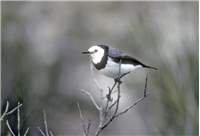Family
Meliphagidae
Genus
Epthianura
Species
albifrons
Threats/Control Methods - Regional
These birds are susceptible to the effects of water pollution through the loss of food, or the build up of toxins. Strong storm events result in runoff into the waterways, silting up the water with dirt and rubbish, producing unsafe algae levels and chemical concentrations.
Threats/Control Methods - Local
Free-roaming domestic pets may attack this ground-dwelling species. Their wetland habitat is also put at risk by the contents of our suburban storm water drains, which run directly into Canberra's lakes and rivers without treatment.
Local/Urban Actions
There are many simple precautions residents can take to ensure waterways remain unpolluted. Chemical fluids should go to specific waste management sites. The Canberra Connect helpline on (02) 6207 9777, has all the information on specific chemical waste disposal questions. It is also helpful to avoid vegetation, dirt or mulch building up in gutters and drains by raking it up off the street or concreted areas and then placing it into the compost or taking it to 'Corkhill Brothers' at Mugga Lane Landfill or 'Canberra Sand and Gravel' at Parkwood Road Recycling Estate. Dog walkers should keep pets on a lead and to collect all faeces and dispose of it in rubbish bins. Cat owners can prevent their pets from hunting by installing a cat run or enclosure.
Common Names
White-fonted Chat, Tin-tack, Tang, Moonface, Baldy-head.
Distinguishing Features
The male bird is recognisable due to its yellow eye on its bright white face and throat, encircled by a thick, black band from the back of the head and down across the breast. The back and rump are silvery -grey, while the wings and tail are dark brown, tipped with white. The underparts are also white. Female birds are paler, with a grey-brown face, back, wings and tail. Underparts are creamy-white with a dark-brown band across the breast. Young birds are similar to females, lacking a distinct breast band.
Survey Techniques
Call and visual identification.
Species Call
A metallic, nasal 'tang' given in flight.
Similar Species
This is a very unique looking species, however the white face gives it slightly similar colourings to the much larger ocean birds.
Distribution
This species is found across the southern half of Australia, from central WA across to northern NSW.
Country of Origin
Australia
Conservation (Pet/Pest) Status - Regional
This species is rare to see, as it only found in very low numbers in this region.
Conservation (Pet/Pest) Status - National
Secure, not listed under the EPBC Act 1999.
LSCCES Population
Six birds were seen on Black Mountain Peninsula.
Associated vegetation community
The White-fronted Chat inhabits open areas, heath, coastal estuaries and swampy vegetation patches on farmlands.
Limiting Resources
This species is depentant on water-bodies and their surrounding vegetation for an ideal habitat. Within the Canberra region, these areas may be around Lake Burley Griffin or the Jerrabomberra wetlands.
Breeding
The breeding season of the White-fronted Chat runs from July to January. It builds a relatively large cup-shaped nest hidden in some low shrubs or reeds, less than one metre from the ground. The outer nest is built from sticks and grass, lined with fine grass and hair. Both parents share the 2-week incubation period and care for the young for a further 14-15 days before they leave the nest.
Behaviour
This species is highly social, nesting in large colonies. It has a bouncy flight technique, staying fairly high and calling. It is usually quite obvious around agricultural or wetland areas, seen searching for insects on the ground or in low shrubs. However, it has very secretive nesting behaviour, doing distracting displays to avoid the exact whereabouts of the nest being known.
Functional Group
Food Species
The White-fronted Chat will collect small insects of about 5mm in size, including midges (Chironomidae), kelp-flies (Coelopa frigida), plant bugs (Lygus lineolaris) and beetles (Coleoptera).
Predators
Due to the low lying position of the Chat's nest, many predators, such as the European Red Fox (Vulpes vulpes), Dogs (Canis familiaris) and Cats (Felis catus) are able to attack young birds.
Interesting Fact
The White-fronted Chat has a brush-tipped tongue like honeyeater birds, however this species doesn't use it to drink flower nectar, preferring to run along the ground chasing insects.
References - (reader suitability of references, P=Primary teachers, S=Secondary students, T=Tertiary students and researchers)
Books:Morcombe, M. 2000. Field Guide to Australian Birds. Steve Parish Publishing. Archerfield. Australia P, S, T
Taylor, M and Day, N. 1993. Field Guide to the Birds of the ACT. National Parks Association of the ACT Inc. Canberra. P, S, T
Internet: Birds in Backyards. 2006. [online]. Available at:http://www.birdsinbackyards.net P, S, T
Online Publications:ACT Government. 2006. Information Sheet: Stormwater Pollution from Residential Areas. Environment ACT. [online]. Available at: http://www.environment.act.gov.au/__data/assets/pdf_file/13168/Stormwater_Pollution_from_Residential_Areas.pdf P, S, T
Nix, H. and Cunningham, R. 2006. Birds of the Lower Sullivans Creek Catchment, Canberra ACT. Prepared for the Life in the Suburbs project using data from the Lower Sullivans Creek Catchment Ecological Survey (LSCCES). Australian National University. Canberra. [online]. Available at: http://www.lifeinthesuburbs.com.au/category.php?id=65 S, T

 Top
Top Top
Top